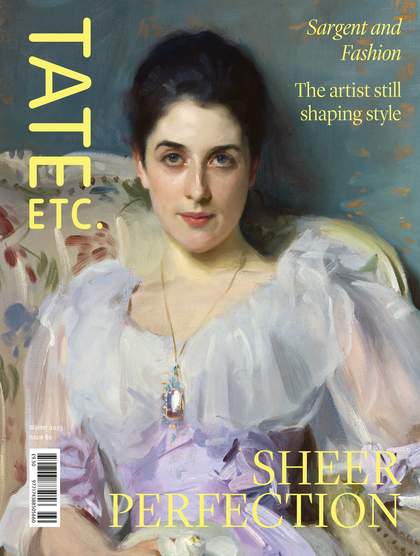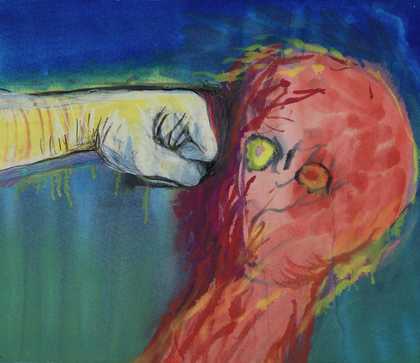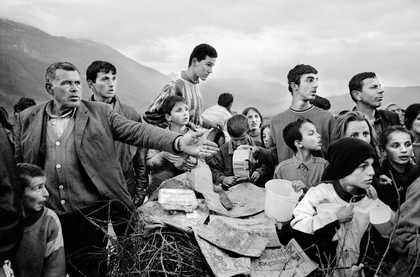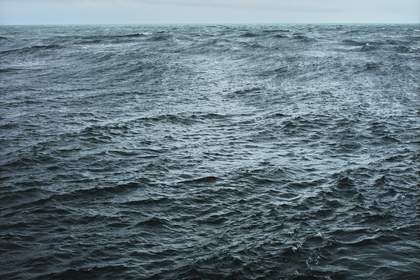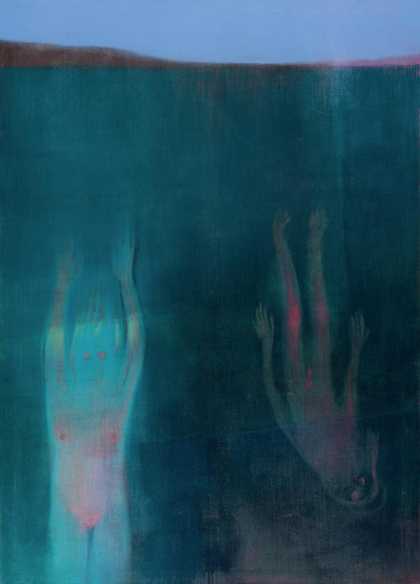
Miriam Cahn
The Beautiful Blue (2008–2017)
Tate
The Swiss artist Miriam Cahn’s startling painting, The Beautiful Blue 2008–17, depicts a harrowing scene of two figures – one female, the other male – sinking into a dark sea beneath a bright, cloudless sky. The woman falls with her arms outstretched as if she has jumped feet first into the water while the man descends headfirst. The blue surrounding them appears at once tranquil and foreboding. Their eyes are reduced to haunting, lifeless dots, and their bodies share trails of red that stretch from their limbs to their cores. A shaft of light across the woman’s forehead is hopeful but fleeting, dull by the time it reaches the man’s knees as the bodies fall to their fate. Inspired by the movement of refugees and migrants across the Mediterranean, this ghostly work brings to the fore the treacherous journeys and deaths of those who risk all in search of safety and hope.
In 2015, Europe witnessed a rapid increase in migrants and refugees, with 1.3 million people seeking asylum. This marked the most significant number of arrivals in a single year since the Second World War, leading to what became known as the ‘migrant crisis’. Most of these individuals came from Syria, Afghanistan, Iraq and Eritrea and were driven by various factors, including conflict, economic hardship and climate change. Since the beginning of the ‘crisis’ and beyond, hundreds of thousands of migrants and refugees have crossed the Mediterranean to Europe, travelling along exceptionally dangerous migratory routes that claim thousands of lives every year.
Cahn is no stranger to spotlighting contentious subjects. Often described as an ‘activist artist’, she has traversed boundaries in her decades-long practice, capturing topics from violence against women to conflict in Iraq and the representation of refugees in the Balkans. With palpable anger, her work questions the prevailing norms that disregard humans in need and pushes us, the viewers, to rethink our perceptions. In The Beautiful Blue, Cahn not only reminds us about the plight of those forced to embark on perilous journeys, but also challenges us to make sense of the narratives that have shaped our collective perceptions of migrants. More than a piece of art, the work is a mirror held up to society, reflecting its ugly blemishes.
The trouble is that our view of migrants is woven through a highly problematic media lens, which consistently frames migrants as either victims or intruders, reducing their experiences to mere debating points and sidelining their humanity. We skim through images of small boats, barbed wire and faceless masses accompanied by reportage pre-laden with alarmist narratives (are they here to steal our jobs? Do they pose a threat to our way of life?).
In September 2023, a record number of people crossed the Mediterranean and arrived on the Italian island of Lampedusa to seek refuge in Europe. Conservative politicians and newspapers used inflammatory, degrading terms (such as ‘surge’, ‘overwhelmed’, ‘flooded’, ‘illegal’ and ‘invasion’) to condemn their arrival, portraying it as a dangerous occupation rather than a humanitarian emergency. Framed another way, we might recognise that these migrants and refugees had arrived on a continent of over 700 million people with an economy of $24 trillion rooted in colonial plunder, mass capitalist extraction and climate damage. Yet we rarely hear this expressed in media coverage.
Cahn’s painting of two figures drowning in the Mediterranean points to the callous indifference with which Europe has treated the needless deaths of migrants in the expanse of water the Romans christened mare nostrum (in Latin, ‘our sea’). (In his concluding comments during a recent conference held in the port city of Marseille, Pope Francis warned that the Mediterranean is becoming ‘the mare mortuum’ (sea of death) and a ‘graveyard of dignity’.) Cahn’s work might make us think of the Italian academic Alessandra Di Maio’s use of the term the ‘Black Mediterranean’ to spotlight how this sea is a racialised border guarded with the tools of oppression.
Cahn has consistently harnessed her art to capture uncomfortable truths about society. Yet, what sets her work apart is a profoundly empathic approach towards her subjects. Though her work confronts us with harrowing visuals, there’s a clear intent to disarm the negative lens and restore a sense of shared humanity. The artist has described how she draws from her Jewish roots to empathise with migrants from outside Europe (she once said it was her ‘duty’ to use her position to spotlight the pain of others). Other thoughtful artistic reflections on the 2015 mass migration include 2016 by Maggi Hambling, in which an upturned boat disappears beneath rippling waves as light flickers off the choppy blue waters. Rather than painting from a single photograph, Hambling based the work on photos and news reports she came across, underscoring how the images of the ‘crisis’ have fundamentally shaped our view of migrants. Similarly, Cahn offers a dynamic window into the individual migration experience.
In The Beautiful Blue, Cahn creates a space for us to explore the power of art as a means to express profound truths. The work beckons us to look beyond the surface, to see the humanity in every migrant and to recognise the profound acts of survival and imagination that drive their journeys. It reminds us that the migrant experience is not only shaped by political, media or economic narratives but is, at its heart, a deeply personal, human experience. By viewing the migration experience in this way, through the lens of contemporary art, we free it from being measured solely by its political or economic dimensions, and in doing so, its shape emerges fuller, more profound, humane and truthful.
Although The Beautiful Blue depicts an unspeakably tragic scene, it also speaks to the migrants’ journey of setting out in hope. In Somali, the term buufis relates to this idea. Meaning ‘to blow’ or ‘inflate’, it encapsulates a sense of yearning to find a new home abroad. The word also evokes the spiritual dimensions of migration in a culture marked by decades of displacement. This could include Somali refugees living in Dadaab, Kenya’s largest refugee complex, or those who arrived in Britain in the 1990s, like my own family.
Looking at Cahn’s painting, it’s hard not to feel a surge of emotion, perhaps a sense of empathy. It becomes clear that acts of migration aren’t just about survival but are profound displays of hope, courage and imagination. And, as art shows us, imagination knows no borders – it can take us anywhere we dare to dream.
The Beautiful Blue is included in Capturing the Moment at Tate Modern until 28 April 2024. The exhibition is realised in collaboration with the YAGEO Foundation, Taiwan. The YAGEO Foundation was founded by Taiwanese collector, entrepreneur and philanthropist Pierre Chen in 1999. The exhibition is curated by Gregor Muir, Director of Collection, International Art, Tate; and Beatriz Garcia-Velasco, Assistant Curator, International Art, Tate Modern.
Ismail Einashe is a journalist and writer, and member of the Tate Etc. editorial board.

